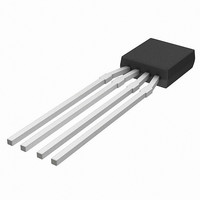KMZ10C,112 NXP Semiconductors, KMZ10C,112 Datasheet - Page 33

KMZ10C,112
Manufacturer Part Number
KMZ10C,112
Description
IC MAGNETIC FIELD SENSOR SOT195
Manufacturer
NXP Semiconductors
Type
Special Purposer
Specifications of KMZ10C,112
Sensing Range
2mV/V
Voltage - Supply
5 V ~ 10 V
Output Type
Analog
Operating Temperature
-40°C ~ 150°C
Package / Case
SOT-195
Mounting Style
SMD/SMT
Maximum Operating Temperature
+ 150 C
Minimum Operating Temperature
- 40 C
Supply Voltage (min)
5 V
Supply Voltage (max)
10 V
Operating Temperature (min)
-40C
Operating Supply Voltage (typ)
5V
Lead Free Status / RoHS Status
Lead free / RoHS Compliant
Current - Supply
-
Current - Output (max)
-
Features
-
Lead Free Status / Rohs Status
Lead free / RoHS Compliant
Other names
933698480112
KMZ10C T/R
KMZ10C T/R
KMZ10C T/R
KMZ10C T/R
Philips Semiconductors
T
As the number of vehicles using already congested roads
steadily increases, traffic control systems are becoming
necessary to avoid time consuming traffic jams. These
systems monitor traffic flow, average speed and traffic
density, allowing electronic road signs to control the flow
and speed of traffic at known trouble spots. They also have
the advantage of indicating possible incidents, where
traffic speeds fall significantly below average on certain
sections of road. Simple modifications to these systems
allows them to be used to improve safety, and also to
monitor ground traffic at airports.
1998 Jun 12
handbook, halfpage
handbook, halfpage
RAFFIC DETECTION
Magnetic field sensors
Fig.38 Geometry error - North/South trapezoid.
Fig.37 Geometry error - horizontal picture tilt.
MBH628
MBH627
33
Although highly sophisticated computer systems are used
to analyse the various inputs in traffic systems, currently
this input information is gained from inductive systems
which have a number of disadvantages. The low sensitivity
offered by inductive measuring systems requires large
areas of road to be lifted and re-surfaced during
installation. With their high power consumption, and the
fact they produce very little information regarding the type
of traffic passing over them, makes them both costly and
inefficient. They are also rather unreliable due to road
thermal stress.
As practically every vehicle manufactured contains a high
number of ferromagnetic components, a measurable
magnetic field specific to an individual model from every
manufacturer can be detected, using weak field
measurement techniques with magnetoresistive sensors.
Even with the greater use of aluminium in manufacture and
if the vehicle has been demagnetized, it will still create a
measurable change in geomagnetic field strength and flux
density.
In comparison with inductive methods, with its high
sensitivity magnetoresistive measuring can provide
information on the passing vehicle type. Also, due to the
sensor size and placement, systems can be easily and
quickly installed in any stretch of road, or even by the side
of the road, if necessary. Combined with almost negligible
power consumption, this makes magnetoresistive control
systems an inexpensive and highly efficient method of
monitoring traffic levels.
A. Measurements on roads
A field test with three-dimensional sensor modules was
set-up, firstly to measure the signals of different vehicles;
and secondly, the relative occurrence of signal values of
three vehicle categories (car, van and truck). For the first
test, one module was placed in the road, under the vehicle
and for comparison, a second module was placed at the
side of the road. For the second test, which was performed
‘live’ on a street in Hamburg, Germany, the module could
only be positioned at the side of the road.
The local geomagnetic field was calibrated to zero, so that
only the disturbance in the field caused by the passing
vehicle would be recorded. Figure 39 shows the spectra
produced by an Opel Kadett.
General














